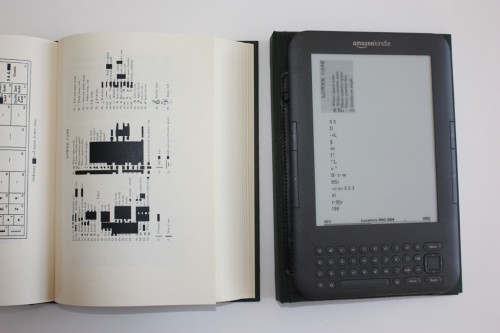I have an early Kindle. It displays one and only one font (roman only) and no graphics. One of the first books I bought to read on it used italics to denote which character was speaking, which was lost on me, and made the book very confusing. Later, before I learned my lesson for good, I got a history book that had maps & charts in the printed version but not the Kindle version. That one was so confusing I gave up and got the print version from the library. So I really enjoyed Modern Methods of Book Composition, an artist book by Tim Schwartz that I saw at Codex today. According to Tim’s website:
Theodore Low De Vinne is one of the fathers of book publishing in America. He was one of the nine founders of the Grolier Club, the commissioner of the font Century, and the most prolific writer on book publishing methods in the late 19th century. In 1904, De Vinne wrote “Modern Methods of Book Composition,” a treatise on how to layout and publish books.
In 2007 the University of California Libraries scanned in the pages of this book and uploaded the files to archive.org…After the files were uploaded the content of the book was automatically extracted and a variety of digital book formats were created, including one for the Kindle.”
Of course the figures and illustrations were stripped from the Kindle version. Tim printed the scanned version, and redacted much of the text, leaving pretty much only the illustrations. He says
A piece of software was written to take a page from the original book and cover up any content that was extracted with a black box. By repeating this process for every page in the original book, a new book was created that shows only the layout of the original book, that was lost in the digital copy, and leaves uncovered the content that was unable to be converted into the digital version.
Then he packaged this version with a Kindle with the non-illustrated text. Making, I suppose, a complete book. Here’s a picture of it. See more here.


I was lucky enough to discover your blog a few weeks ago (especially lucky as I just live “up the hill” from you) and have greatly enjoyed it. So thank you!
This post is very interesting. I’d like to add a factoid about the Kindle which isn’t meant to dispute the general thrust of the post. You can download a Kindle app for free on almost any computer you have, including a tablet, and register it with Amazon. Then when you buy a Kindle book, you can download it to any or all of your registered Kindle apps as well as to your physical Kindle if you have one. The apps display everything that is in the ebook including color and pictures.
As a designer/teacher/typographer I love the Kindle for the freedom it gives me. I have 50-60 books uploaded at anyone time. Most from Project Gutenberg. And, best of all, it fits in my inside jacket pocket.
I am convinced that e-readers are one of the most important inventions for avid readers since moveable type.